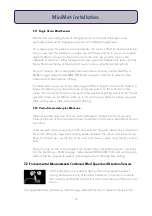
9. MOUNTING THE BAROMETER / AIR PRESSURE SENSOR
The barometer is usually mounted using a short arm bracket. If you have
purchased the sensor plus its accessory directly from Skye, the bracket will
already have been fitted to the instrument for you, ready for mounting.
If you have purchased the items separately, please follow these
instructions to fit the mounting bracket to your sensor.
Unscrew the 4 screws on the top of the barometer casing and remove the top, you will see the instrument
case has a 'double skin'. There are four mounting holes outside the inner compartment, one in each corner,
which are used for attaching the mounting bracket. Screw the instrument case to the screen using the supplied
nuts and bolts. You will need a small, long screwdriver for this job. Note that even though the instrument
casing is square, the mounting holes are not squarely placed.
Tighten these four mounting screws securely but gently, and replace the instrument top. TAKE CARE to
orientate the top correctly to prevent damage to the soft rubber 'O' ring seal.
The short arm bracket has four mounting holes on its back plate, suitable for bolting to a wall or vertical
surface. It is supplied as standard with a pair of 'V' bolts, washers, nuts and end caps used for fixing to a
pole or mast up to a maximum diameter of 50 mm. See Appendix 5.
Plug and screw up (do not overtighten) the barometer sensor connector into the DataHog or MiniMet logger
socket marked AIR PRESSURE and use plastic cable ties to prevent cable movement and damage from
rubbing.
Barometer sensors can be mounted at almost any position. Sensors SKPS 800 and 810 are fully temperature
compensated and can be installed in any exposed site without loss of accuracy. The barometer SKPS 820 is
not temperature compensated, so care should be taken to install this sensor in a sheltered place, such as on
the side of a building, in a glasshouse or shed, where extremes of temperature will not affect measurements
too greatly.
All Skye barometer sensors measure absolute air pressure at their installed site. If air pressure relative to sea
level is to be measured, the altitude of the installed site must be taken into account. This can be done
directly in the DataHog loggers, by adjusting the zero offset for the sensor calibration factor in software. The
calculation instructions for this, and for using with other dataloggers is given in the barometer manual.
22
MiniMet Installation
Содержание MiniMet
Страница 1: ...MiniMet Installation Manual Iss 2 0...
Страница 45: ...APPENDIX 2 CONCRETE BASE FOR A 2M MAST 44 MiniMet Installation...
Страница 46: ...APPENDIX 3 SITE LOCATION 45 MiniMet Installation...
Страница 47: ...APPENDIX 4 ASSEMBLY OF MAST SUPPLIED IN MORE THAN ONE SECTION 46 MiniMet Installation...
Страница 49: ...APPENDIX 6 RAINGAUGE BASEPLATE 48 MiniMet Installation...
Страница 50: ...APPENDIX 7 MOUNTING OF GSM GPRS ENCLOSURE TO BRACKET 49 MiniMet Installation...
Страница 51: ...APPENDIX 8 MOUNTING THE GSM GPRS MODULE ON THE MAST NO SOLAR PANEL 50 MiniMet Installation...
Страница 52: ...APPENDIX 9 MOUNTING OF THE GSM GPRS UNIT ON THE MAST WITH A SOLAR PANEL STEP 1 51 MiniMet Installation...
Страница 53: ...APPENDIX 10 MOUNTING OF THE GSM GPRS UNIT ON THE MAST WITH A SOLAR PANEL STEP 2 52 MiniMet Installation...
Страница 54: ...APPENDIX 11 MOUNTING OF GSM GPRS UNIT ON THE MAST WITH A SOLAR PANEL STEP 3 53 MiniMet Installation...
Страница 55: ...APPENDIX 12 TYPICAL MINIMET INSTALLATION WITH GSM GPRS 54 MiniMet Installation...
Страница 56: ...APPENDIX 13 TYPICAL MINIMET INSTALLATION WITHOUT GSM GPRS 55 MiniMet Installation...
Страница 57: ...APPENDIX 14 56 MiniMet Installation...
Страница 58: ...APPENDIX 15 FITTING THE BATTERY COVER 57 MiniMet Installation...
















































